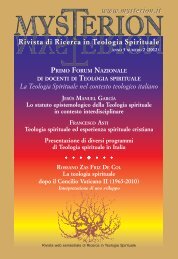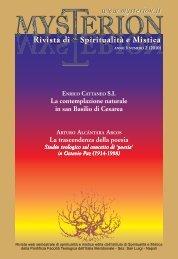Mysterion - rivista di spiritualità e mistica
Mysterion - rivista di spiritualità e mistica
Mysterion - rivista di spiritualità e mistica
You also want an ePaper? Increase the reach of your titles
YUMPU automatically turns print PDFs into web optimized ePapers that Google loves.
www.MYS ERION.it<br />
W.R. STOEGER S.J.<br />
68<br />
1 (2008) 64-77<br />
However, there are very small perturbations or fluctuations in the CMWBR – of the<br />
order of 1 part in 100,000. These temperature fluctuations mean that the density of the<br />
plasma at that time (300,000 years after the Big Bang) had slight overdensities and underdensities<br />
(perturbations) in it of the same magnitude. As I have already mentioned, these<br />
overdensities are the seeds of clusters of galaxies and of galaxies. After decoupling they<br />
gradually grew in strength, under the influence of their local gravitational fields, and then<br />
collapsed and fragmented to form the structures we now see throughout the cosmos.<br />
But where <strong>di</strong>d these perturbations, or seeds, in the cosmic plasma come from? Without<br />
them we would not be here! We are not completely sure. But it is very likely that they<br />
were generated in the first split second after the Big Bang by what cosmologists refer to<br />
as “inflation.” Inflation is extremely rapid expansion of the universe – exponentially<br />
rapid expansion – during which the universe expanded by at least 30 orders of magnitude<br />
in an extremely short time. Inflation, if it occurred, began and ended well before the<br />
universe was 1 second old. Super-rapid expansion also means supercooling, of course.<br />
Thus, when inflation slowed down and stopped, much of the energy from the inflationary<br />
field was transformed into reheating the universe back to the temperature it had<br />
just before inflation. Unfortunately, we do not have definitive evidence for an inflationary<br />
epoch; we don’t have any evidence against it, either. It turns out that it is very<br />
<strong>di</strong>fficult – if not impossible – to explain a number of facts about the universe without it.<br />
In particular, inflation can easily and quickly generate and preserve these perturbation<br />
seeds we need for later galaxy formation. Also, without inflation it is almost impossible<br />
to account for why the CMWBR in every <strong>di</strong>rection should be of almost the same temperature<br />
and the same amplitude. Without inflation the <strong>di</strong>fferent regions of the cosmic fog<br />
bank in slightly <strong>di</strong>fferent <strong>di</strong>rections would have been causally <strong>di</strong>sconnected – not enough<br />
time would have elapsed from the Big Bang for them to communicate information to<br />
one another – and there would therefore be no explantion why they should then be of<br />
the same temperature, as they indeed are.<br />
We already in<strong>di</strong>cated that one of the first transitions that occurred imme<strong>di</strong>ately after<br />
the Big Bang was the emergence of gravity and space-time as we know them. It is very<br />
interesting to go back for a minute to this period right after the time of the Big Bang<br />
itself and consider the many important transitions that occurred in the first second.<br />
Before doing this is it important to remember that all of physics can be summarized in<br />
four forces or interactions: gravity, electro-magnetism, the strong nuclear force, which<br />
holds nuclei together, and the weak nuclear force, which explains certain types of nuclear<br />
transitions and decays. The key idea is that these four interactions were almost certainly<br />
not always separate – that at very, very high temperatures they were unified, or<br />
in<strong>di</strong>stinguishable from one another. Thus, at the very beginning – at the Big Bang itself<br />
– there was probably just one superforce, which included gravity, electromagnetism,and<br />
the strong and weak nuclear forces. But when the temperature fell in the first split<br />
second to below 1032 K, gravity – and classical space and time with it – separated from<br />
the combination of the other three (which is called the Grand Unified Theory (GUT)<br />
interaction). A short time later, when the temperature had fallen to 1027 K, the strong<br />
nuclear force became <strong>di</strong>stinct from the remaining electroweak interaction, and at a much<br />
lower temperature, 1015 K – which still corresponds to only a millionth of a second







